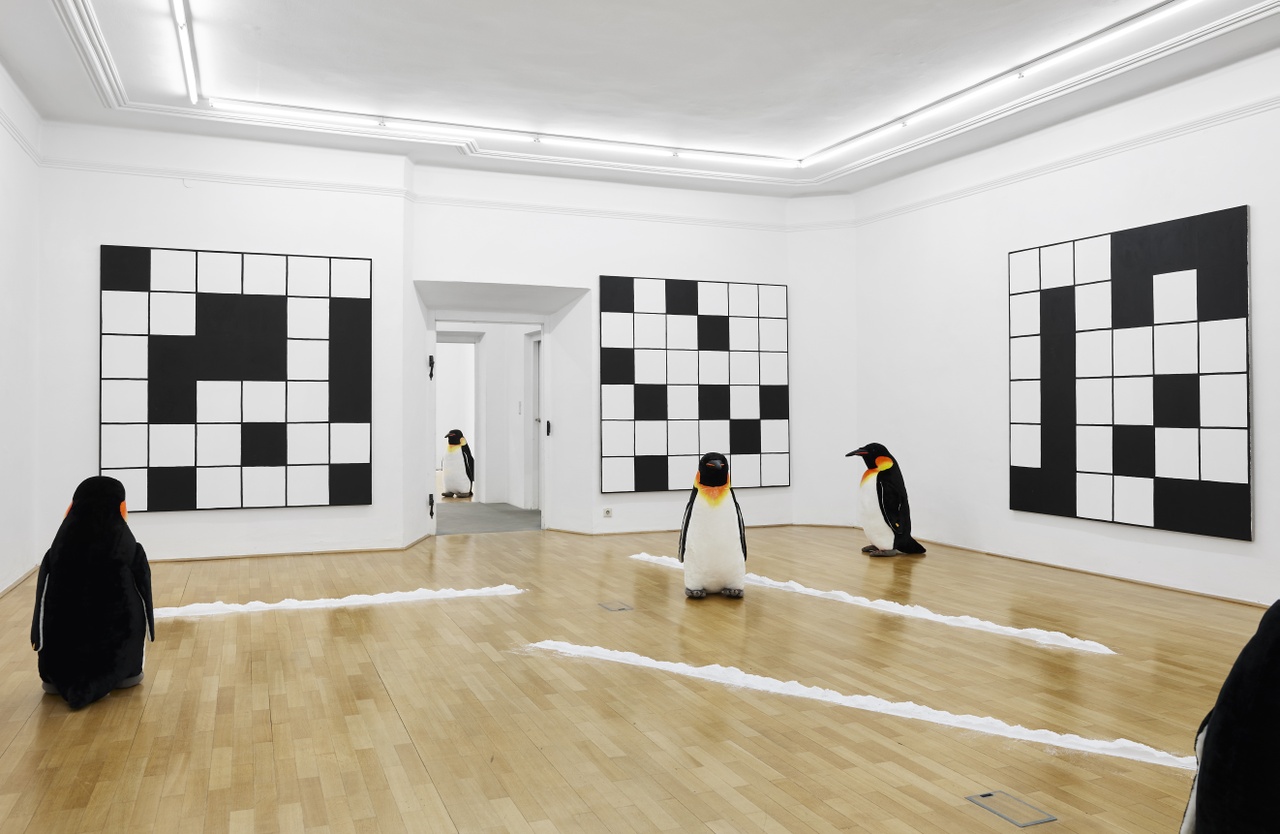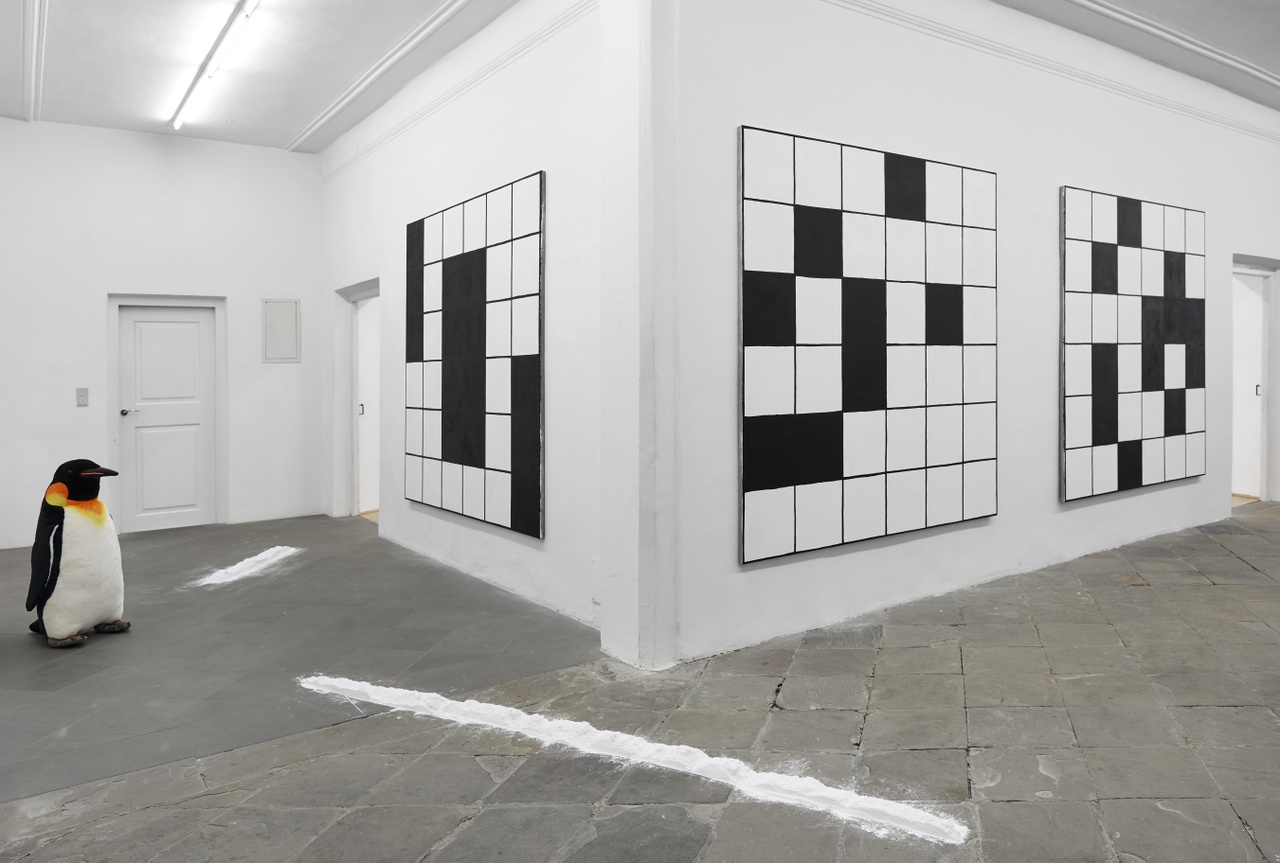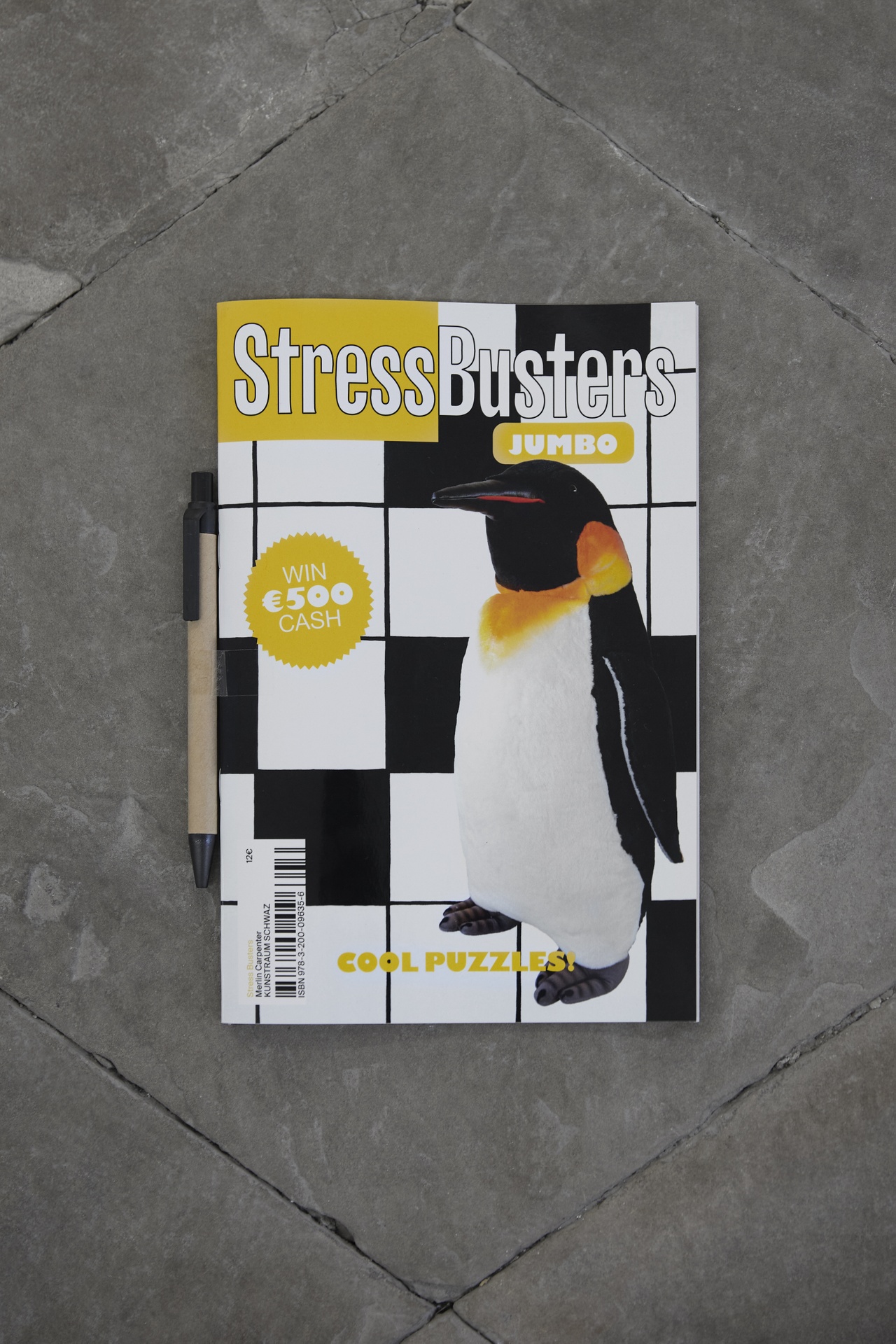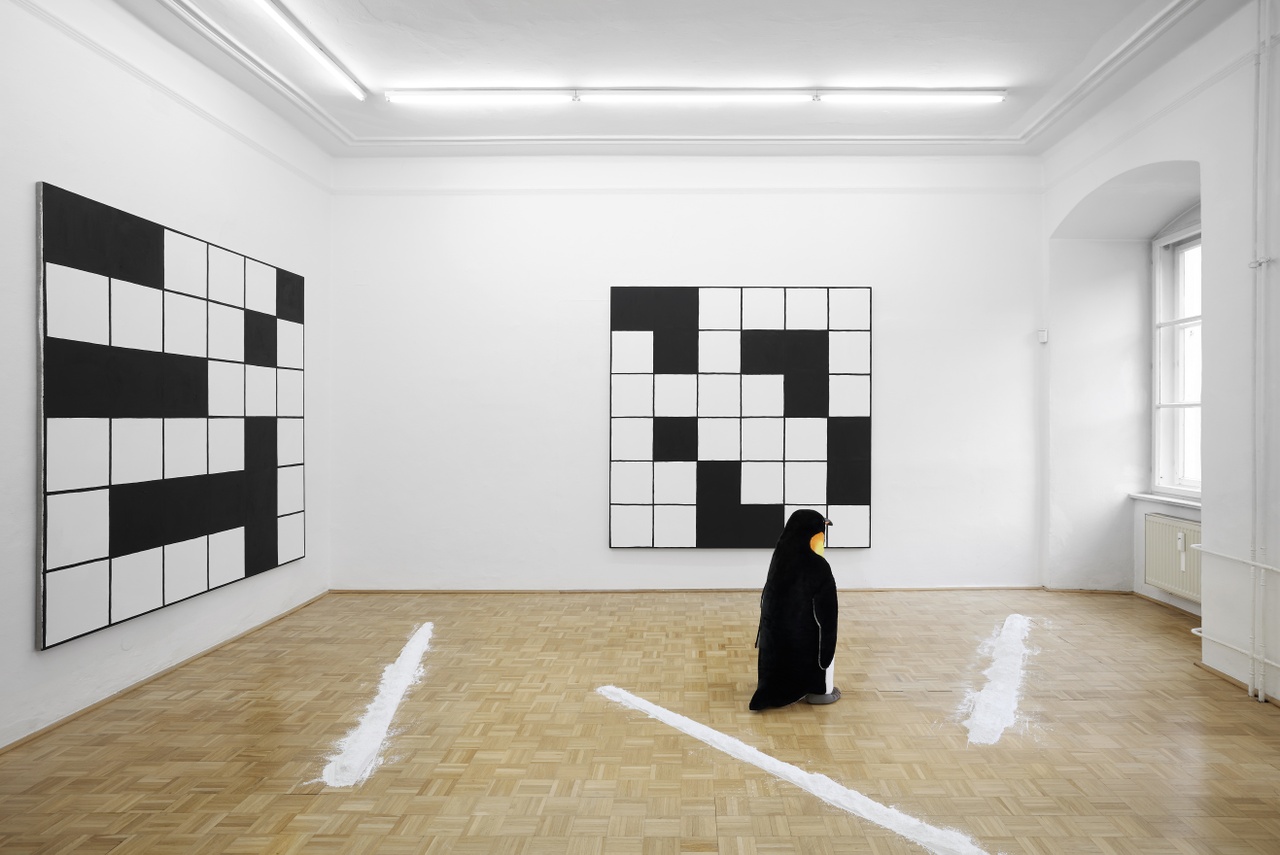PENGUIN POTBOILER David Homewood on Merlin Carpenter at Kunstraum Schwaz, Austria

“Merlin Carpenter: Stress Busters,” Kunstraum Schwaz, 2024
Merlin Carpenter’s recent show “Stress Busters” is an arrangement of life-size plush toy penguins, white marble dust swept into long mounds suggestive of massive lines of cocaine, and large grid paintings of black and white squares that bear a resemblance to crosswords. If this grouping seems somewhat random, the exhibition title hints at the shared status of these things as forms of popular distraction: toy, drug, word game; things that evoke diversion from the here-and-now, ways to overcome boredom, fun pastimes. An art exhibition too is a sort of distraction; what kind of experience is afforded here, in this distraction of distractions?
True to its title, a spirit of lightness if not frivolity pervades “Stress Busters.” The contents are exotic and eye-catching, a wired conglomeration of shopwindow display, natural history diorama, escape room, and picture salon – yet it isn’t quite any of these. In its bizarre juxtapositions, scalar distortions, and psychotropic referentiality, the scene is closest to a cheapo 3D rendering of surrealist phantasmagoria: a Magrittean roomful of jumbo crosswords, meter-long “snow” lines, Antarctic birds, and a window-framed vista of snow-capped mountains. But this is technically a misrepresentation, since Carpenter’s show isn’t confined to one room; rather, it is spread across three interlinked rooms of Kunstraum Schwaz. Since one encounters the same relative number of penguins, lines, and paintings in each room – five of each specimen in the main gallery, four in the L-shaped entrance hall, three in the alcove – the spaces seem interchangeable, the gist of the whole contained in each of its homogeneous parts.
The 1:1:1 ratio of objects in each room underscores the equivalence of rooms as well as objects: the sameness of the three distraction-objects and their twelve materializations (apparitions?) – 36 items in total, one for each square in a six-by-six grid. The store-bought birds are identical, the floor stripes are uniformly broomed. Even the paintings, despite their compositional particularities, feature the same grid system and colorless binary palette and could be mistaken for iterations of a single work. As the spectator wanders hazily amid this crowd of near-copies, each room a version of the one before it, there is no discernible focal point or climax. Carpenter’s version of “le merveilleux” is repetitious and therefore underwhelming, a phantasmagoria of creeping boredom.
A yawn, an involuntary open-mouthed inhalation accompanied by a shutting of the eyes, typically registers the boredom of the spectator. In “Stress Busters” it confirms the uptake of an expertly administered sedative or anaesthetic. Because the artist, it turns out, is in the business of yawn-inducement. Since the beginning of his career in the early 1990s, he has frequently inflated audience expectation only to systematically – deliberately – disappoint it. The self-consciously failed one-liner is one in a bag of tricks comprising Carpenter’s performative examination of artistic production under late capitalism – the general conditions in which culture, he can explain in competent Marxist parlance, distracts its alienated subjects. Neither the alienation nor the perceptual zoning-out of the subject are his inventions; they’re endemic in a world of proliferating distractions. Carpenter just has a knack for mimetically doubling the existing state of things for an audience.

“Merlin Carpenter: Stress Busters,” Kunstraum Schwaz, 2024
Yawning pertains to “Stress Busters” insofar as the show provokes a state of bored dreaminess, a mental withdrawal from one’s surroundings that intensifies in sleep. Even if the spectator doesn’t nod off, the exhibition pertains to sleep via a dreamlike logic of concoction, which recalls Sigmund Freud’s Interpretation of Dreams (1899), referenced by Carpenter in past exhibition texts and his 2018 book The Outside Can’t Go Outside. Freud understands the “manifest content” of a dream, the conscious individual’s recollection of it, as an expression of its so-called latent content: the individual’s unconscious desires that cannot be fulfilled in waking life. [1] As part of the conscious individual’s repression of these desires, Freud claims, latent content is disguised through processes of condensation (minimizing or concentrating a thing) and displacement (substituting one thing or feeling for another).
It is as if Carpenter flipped the telos of dream interpretation from reception to production, co-opting the theory as a manual for artificial dream production or surrealist exhibition-making. The manifest content or form of “Stress Busters” is shaped by a series of operations – material, analogical, illusionistic – applied to its founding premise: culture is distraction. Carpenter seemingly worked backwards from this hypothesis, instrumentalizing the concepts of condensation and displacement as formulae for generating a blizzard of interconnections: snow and snow, line and line, classical sculpture and dusty mess, toy as sculpture, nose candy and visual confectionary, painting and game, avian effigy and shrunken spectator, and so on.
If this is a dream of distraction, Carpenter hasn’t disguised its latent content. Maybe that’s the point: blinking “distractions” at every turn. The artist’s treatment of the theme “stays on the surface,” for, as he explained in a 2020 press release for a show of electrical circuit diagram – like paintings, the truth of culture, like the unconscious, hides in plain sight. [2] Hence “Stress Busters” revels in its superficiality superficially, as it were, rehashing tropes of the contemporary art exhibition – its own medium of distraction. Indeed, this spectacle of retro-Boolean grid abstractions, druggy post-minimalist anti-forms, and German-made Antarctic plush-bird readymades is, if nothing else, an exercise in distraction-specificity, one which powerfully invokes the historical eclecticism, stylistic hybridity, interactivity, intergenerational appeal, immersiveness, and ultimately the who-cares-do-whatever ideology of art that prevails today.

Exhibition booklet
Since it is hidden in plain sight, the message of “Stress Busters” is cryptic. The show is a trail of clues, a puzzle to be solved, or, as implied by the analogy between painting and crossword, puzzles within a puzzle. The analogy is pushed to breaking point in the Sebastian Koeck-designed exhibition booklet’s mimicry of a crossword magazine, its glossy cover featuring a lucky penguin (no reference to the video game) against a crossword-painting landscape and a fake offer to “WIN €500 CASH.” Inside the booklet are photographs of the twelve paintings laid out as crossword diagrams with lists of clues on facing pages by artist Richard Parry. “Hollow painting for esteem economy (11, 5)”; “The oppressive nature of the too successful artist (4, 2, 0)”; “Schizophrenic chess piece (4)”; and “Jazz evolution baffles Swiss toddler (6)” are among the stock of absurd and obscure one-liners, definitions, riddles, puns, and in-jokes that enhance the ludic flavor of the exhibition.
If the exhibition booklet has the ostensible appearance of a puzzle book, the relation remains precisely that – an appearance. For these paintings and clues don’t add up to actual crosswords. Even a viewer with only cursory knowledge of this genre of vintage brainteaser knows that a six-by-six format does not allow for sufficient word lengths or configurations. Plus, Carpenter’s canvases are plagued by lone blank cells as well as blank cell clusters – neither are seen in everyday crosswording. Further aberrations include discrepancies between clue word-lengths and available blank squares. Clues to zero-letter words are not found in puzzle rags.
Carpenter’s pseudo-puzzle is deceptive because a puzzle implies a set of rules that determine its internal structure and external boundaries. Finite and therefore solvable, a puzzle promises an engrossment in familiar scenery, a safe mental adventure, the satisfaction of eventually overcoming an obstacle. Carpenter’s non-clues, on the other hand, are markers of willful misdirection as fraudulent as the €500 enticement on the booklet cover. Crosswords are sites of trickery, but this is a laugh at the would-be puzzler’s expense. The exasperated cruciverbalist discovers a disclaimer buried in the colophon: “Solutions will not be published but are to be found within oneself,” a line redolent of spiritual self-help (or abstract painting) more than crossword-setting.
The crossword paintings carry the promise of a fresh new puzzle. The clues, however, are misleading, and in any case, to mark the canvases would be vandalism. Suspended in incompletion, they nonetheless pose an interpretative challenge to the spectator: beyond stating the obvious or filling in the blanks – “this is an abstract painting … oh, it looks a bit like a crossword” – it’s hard to know how to read these works. Their hermeticism derives significantly from their gridded composition. Visually analogous to the tautology, the grid seems to explain itself and thereby repels interpretation; as Rosalind Krauss wrote in her 1979 essay “Grids,” it has proven itself endlessly adaptable to contradictory agendas: materialist to religious, conservative to revolutionary. [3] Mined intensively since minimalism, pop, and op, it continues to sustain contemporary abstractionists such as the Viennese artist Heimo Zobernig, an apparent source for the two-meter-squareness and black-and-whiteness of Carpenter’s grids.

“Merlin Carpenter: Stress Busters,” Kunstraum Schwaz, 2024
Yet this regional signifier is a brief detour, a distraction from the otherwise overwhelming genericness of Carpenter’s grids. His use of the form in this respect notably differs from the postmodernist appropriation art of, say, Sherrie Levine, whose late 1980s Check Paintings directly cite Marcel Duchamp’s chessboard readymade. Rather than replaying a historic “match” in the ongoing “game” of painting, Carpenter offers a composite or stereotype of grid painting scrubbed of art historical reference. Of course, the play of resemblance cannot be totally suppressed – certain scatterings of black cells are asymmetrically balanced in the vein of Piet Mondrian’s “dynamic equilibrium,” others call to mind Richard Paul Lohse, Ellsworth Kelly, or François Morellet. However, these correspondences are inconsistent and equivocal, more the viewer’s paranoid projection than engrained in the object itself.
For Carpenter, the grid functioned as a pre-compositional constraint or rule, its 36 squares blackened selectively, intuitively – with the proviso that he avoid quoting specific works, artists, or movements in the canon of abstract painting. This was seemingly less a rule than a rule of thumb, a loose procedure for generating a sort of “generic novelty.” (Its looseness is metonymized in the freehandedness of the matrices, their neat yet imperfect lines a cartoon of serious geometry.) Insofar as the procedure was followed, the crossword painting series was covertly determined by the entire tradition of gridded abstraction that it pictorially condenses: a canon to which, by default, it begs admittance.
The artist might be impersonating a modernist painter, but his generic grid paintings, which are academic beyond academic, betray real inventiveness. Despite this, one cannot shake the impression that Carpenter’s paintings are malingering in the heroic modernist tradition. Their intentional blandness is “clever” rather than “good,” the product of a gimmicky problem-solving procedure whose real value is disputable. Tastefully understated decoration, they emulate “zombie formalism” of the early 2010s, that uncritical revival of modernist experimentation, which mainly served to line the pockets of investors. In its brash commercialism, zombie formalism merely underscores the commercial condition of all art, a market of high-end fodder in the guise of oil-on-canvas. Carpenter’s pseudo-zombie canvases, from this angle, are tokens of reification, mute expressions of the exhaustion of fine art’s otherworldly pretensions. The artist soullessly follows the soulless trend because it embodies the lot of all art.
What is “Stress Busters” distracting us from? A screwed global economy, war in Europe and the Middle East, fascism back en vogue, violence against minorities, welfare drying up, rising rates of homelessness, environmental destruction, etc. In the art world though, it’s business as usual, as Carpenter’s fun survey of the standardized art lexicon reveals. His desiccated recreation is only hallucinatory because it’s familiar, or camouflaged as familiar: exhibition set with artwork props, simulated white cube adorned with products of artistic labor. The approximation of a status quo art show is more than a fatalistic move. It’s a way of laying bare the situation. Laying bare the situation, paradoxically, by sealing it in the form of distraction-as-distraction, distraction that claustrophobically returns the gaze to the thing staring back at it. “Stress Busters” then doesn’t deliver on its titular promise: at worst, it’s a waste of time; at best a vague irritant – a cheap high in the Tyrolean Alps that leaves the visitor with a headache.
“Merlin Carpenter: Stress Busters,” Kunstraum Schwaz, February 2, 2024–May 4, 2024.
David Homewood is a writer and curator based in Berlin.
Image credit: © Verena Nagl, Kunstraum Schwaz
Notes
| [1] | Sigmund Freud, The Interpretation of Dreams [1899], trans. A. A. Brill (Hertfordshire: Wordsworth Editions, 1997). |
| [2] | Merlin Carpenter, “Circuits: A Simple, Neutral Press Release,” exhibition press release (Brussels: Dépendance, 2020), available at http://www.merlincarpenter.com/circuitspr.htm. |
| [3] | Rosalind Krauss, “Grids,” October 9 (Summer 1979): 50–64. |
